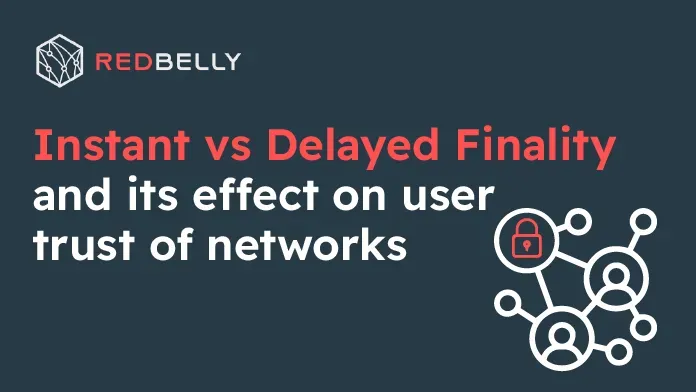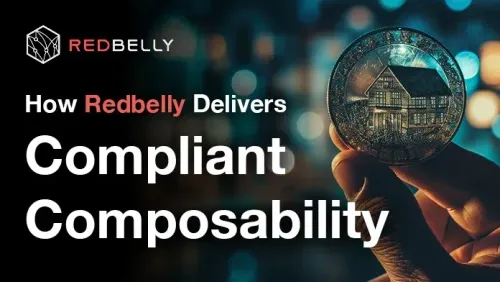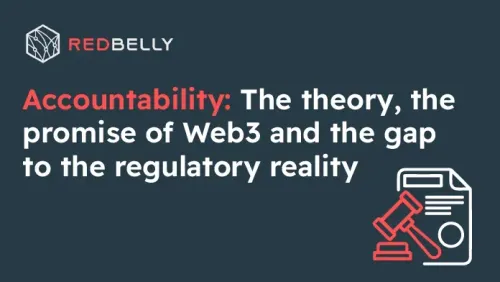Supporters and sceptics alike share a common belief that for Web3 to thrive, it must demonstrate its capacity to address practical, real-world challenges. Blockchain, cryptocurrency and Web3 ecosystems have demonstrated their capability to tackle these issues with varying levels of success, because not all blockchains are created equal.
To enable mass adoption in the future, Web3 solutions must possess a foundation of trustworthiness, reliability, and crucially, speed.

The importance of instant finality
Finality is the guarantee that cryptocurrency transactions cannot be altered, reversed, or stopped. The two types of finality - ‘Instant Finality’ and ‘Delayed Finality’ - refer to the speed at which transactions are considered irreversible on a blockchain and can be confirmed to all parties. These two versions of finality play a pivotal role in determining the overall customer experience (CX) of a layer 1 blockchain network and whether users trust it.
Instant finality provides users with the assurance that their transactions are immediately and irrevocably recorded on the blockchain. This rapid confirmation means confidence for users, eliminating the need to wait for multiple block confirmations that are characteristic of delayed finality systems. The resulting trust is particularly beneficial for businesses aiming to build customer experience centric applications on a layer 1 blockchain.
Instant finality significantly enhances CX by minimising transaction confirmation times, allowing users to interact with the blockchain in real-time, resulting in a seamless transaction like those they might experience in the Web2 world. Compare this with traditional public blockchains which require mining for transactions to be finalised through block matching, or voting for a supermajority on the validity of a proposed block. That takes time, sometimes hours. One very famous public blockchain recently stopped finalising blocks at all, twice, earlier this year.
Delayed finality is fine for users buying something online of low economic value, or with minimal time constraints. For long-term financial investment in equity in a private business, or for selling a multi-million dollar fractionalised property fund into new global markets, delayed finality is simply unacceptable. When the value of the transaction is high, how can we expect users to sit and wait and see if the transaction has been corrupted, hacked or changed by bad actors?
What’s forking got to do with finality?
The problem with many traditional blockchains is forking. Forking occurs when the blockchain separates into many routes, creating multiple, conflicting iterations of the transaction history. This causes delays in finality, and makes determining the correct version difficult.
A loss or delay in finality can result in security issues like reorgs. Reorgs happen when multiple blocks are generated simultaneously, often due to software glitches or malicious attacks. This situation temporarily creates an alternate version of the blockchain, complicating the process of confirming the success of transactions, while the original blockchain version remains in existence. Delayed finality leads to:
Uncertainty in transaction success.
Increased risk of double spending during the delay.
Slower settlement times for financial transactions.
Reduced security and trust in the blockchain network.
Disruption of smart contract operations.
Eroded user confidence in the blockchain ecosystem.
Instant finality reduces the complexity of transaction tracking and reconciliation. Verifying the status of transactions is simple and avoids concern about potential forks, leading to improved user satisfaction and trust in the network.
Layer 1 blockchains that offer instant finality achieve this through advanced consensus mechanisms. Redbelly employs the leaderless Democratic Byzantine Fault Tolerant (DBFT) consensus algorithm to prioritise speed and security, ensuring that finalised transactions are immediately added to the blockchain.
As a Layer 1 blockchain, Redbelly offers instant finality, with no chance of forking or rollbacks, meaning that a transaction on any blockchain project in the Redbelly ecosystem is finalised within seconds. Once a transaction is confirmed, it will never roll back. This guarantee ensures complete trust and reliability, making it ideal for high-value use cases where there is no room for error and time is of the essence.
Failed historical attempts to fix
Over the past decade, as the problems of delayed finality have become more apparent, several different ways of solving this problem have been attempted.
Some blockchain solutions have tried using intermediary d’Apps or Layer 2 hacks to replace the bottlenecks in the consensus mechanisms which slow down the network. However, that just adds complexity and cost to a process that customers need to be fast, simple and trustworthy.
It’s not surprising that traditional public blockchains have struggled to gain significant traction and adoption for use with regulated real world assets. This is partially due to consensus surrounding agreement of nodes and resulting order of transactions on the proposed block.
Classic blockchain consensus often involves fierce competition, where participants propose and vie to impose their own blocks on the system. In this competitive approach, only one participant succeeds. This is a waste of resources as only one participant succeeds and others fail.
In contrast, Redbelly takes a collaborative path to consensus, with participants combining distinct transaction sets into leaderless superblocks. This method increases transaction commitment per consensus instance, improving scalability and overall performance.
Redbelly's consensus is marked by collaboration rather than competition, uniting blocks from various participants into a single superblock appended to the chain at a much faster rate.
Moreover, Redbelly's implementation includes sharded verification. Unlike conventional blockchains where nodes typically verify the same transactions, sharded verification distributes computational load among different verifiers. Each transaction signature is verified by at least t+1 and at most 2t+1 verifiers, based on the maximum number of tolerated faults (t). Superblock optimisation and sharded verification together amplify the scalability of Redbelly Network particularly in relation to regulated real world assets.
Why Redbelly?
Redbelly Network runs on the only formally verified blockchain consensus protocol. Only our consensus has undergone rigorous testing and been formally verified by computer science experts to be secure and reliable.
As a single source of truth, Redbelly dramatically reduces the cost impacts of slow processes, meaning you can increase speed and efficiency and reduce cost, without reducing risk.
Unlike many other blockchains, which often focus on speculative asset trading and fringe cryptocurrencies, Redbelly Network focuses on real-world, high-value assets in regulated markets. This makes Redbelly Network an ideal choice for businesses, enterprises and blockchain projects requiring a secure, decentralised platform for asset tokenisation.
Redbelly not only believes in blockchain’s ability – we have developed solutions that solve real world problems in a compliant way. That’s a big part of what Web3 is about, democracy of access and opportunity, combined with the ownership of our own assets and our own data, and we believe it's a virtuous cause.
Redbelly’s Compliant Asset Tokenisation (CAT) solution improves access, liquidity, choice and efficiency. The solution fixes traditional blockchain issues of delayed finality, anonymity, security and slow throughput to create compliant block space for on-chain tokenisation of high value assets. That’s why we’re going to become the leading blockchain for the next generation of Web3 applications and other blockchain projects.



